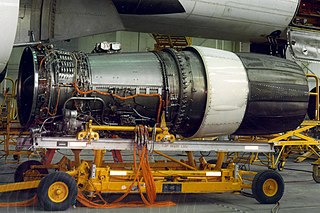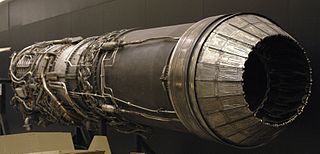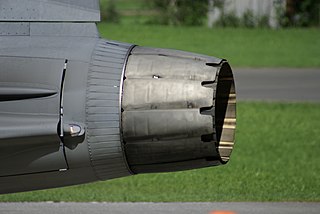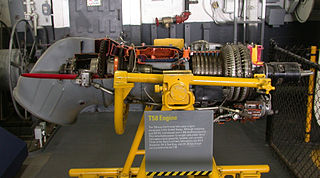Related Research Articles

A turbofan or fanjet is a type of airbreathing jet engine that is widely used in aircraft propulsion. The word "turbofan" is a combination of the preceding generation engine technology of the turbojet, and a reference to the additional fan stage added. It consists of a gas turbine engine which achieves mechanical energy from combustion, and a ducted fan that uses the mechanical energy from the gas turbine to force air rearwards. Thus, whereas all the air taken in by a turbojet passes through the combustion chamber and turbines, in a turbofan some of that air bypasses these components. A turbofan thus can be thought of as a turbojet being used to drive a ducted fan, with both of these contributing to the thrust.

The Eurojet EJ200 is a military low-bypass turbofan used as the powerplant of the Eurofighter Typhoon. The engine is largely based on the Rolls-Royce XG-40 technology demonstrator, which was developed in the 1980s. The EJ200 is built by the EuroJet Turbo GmbH consortium. The EJ200 is also used in the Bloodhound LSR supersonic land speed record attempting car.

General Electric Company, doing business as GE Aerospace, is an American aircraft engine supplier that is headquartered in Evendale, Ohio, outside Cincinnati. It is the legal successor to the original General Electric Company founded in 1892, which split into three separate companies between November 2021 and April 2024, adopting the trade name GE Aerospace after divesting its healthcare and energy divisions.

The General Electric F110 is an afterburning turbofan jet engine produced by GE Aerospace. It was derived from the General Electric F101 as an alternative engine to the Pratt & Whitney F100 for powering tactical fighter aircraft, with the F-16C Fighting Falcon and F-14A+/B Tomcat being the initial platforms; the F110 would eventually power new F-15 Eagle variants as well. The engine is also built by IHI Corporation in Japan, TUSAŞ Engine Industries (TEI) in Turkey, and Samsung Techwin in South Korea as part of licensing agreements.

The General Electric F101 is an afterburning turbofan jet engine. It powers the Rockwell B-1 Lancer strategic bomber fleet of the USAF. In full afterburner it produces a thrust of more than 30,000 pounds-force (130 kN). The F101 was GE's first turbofan with an afterburner.

The Pratt & Whitney F100 is an afterburning turbofan engine designed and manufactured by Pratt & Whitney to power the U.S. Air Force's "FX" initiative in 1965, which became the F-15 Eagle. The engine was to be developed in tandem with the F401 which shares a similar core but with the fan upscaled for the U.S. Navy's F-14 Tomcat, although the F401 was later abandoned due to costs and reliability issues. The F100 would also power the F-16 Fighting Falcon for the Air Force's Lightweight Fighter (LWF) program.

The General Electric J79 is an axial-flow turbojet engine built for use in a variety of fighter and bomber aircraft and a supersonic cruise missile. The J79 was produced by General Electric Aircraft Engines in the United States, and under license by several other companies worldwide. Among its major uses was the Lockheed F-104 Starfighter, Convair B-58 Hustler, McDonnell Douglas F-4 Phantom II, North American A-5 Vigilante and IAI Kfir.

The General Electric/Allison J35 was the United States Air Force's first axial-flow compressor jet engine. Originally developed by General Electric in parallel with the Whittle-based centrifugal-flow J33, the J35 was a fairly simple turbojet, consisting of an eleven-stage axial-flow compressor and a single-stage turbine. With the afterburner, which most models carried, it produced a thrust of 7,400 lbf (33 kN).

The General Electric F404 and F412 are a family of afterburning turbofan engines in the 10,500–19,000 lbf (47–85 kN) class. The series is produced by GE Aerospace. Partners include Volvo Aero, which builds the RM12 variant. The F404 was developed into the larger F414 turbofan, as well as the experimental GE36 civil propfan.

The General Electric F414 is an American afterburning turbofan engine in the 22,000-pound thrust class produced by GE Aerospace. The F414 originated from GE's widely used F404 turbofan, enlarged and improved for use in the Boeing F/A-18E/F Super Hornet. The engine was developed from the F412 non-afterburning turbofan planned for the A-12 Avenger II, before it was canceled.

Reaktionsmotor 12 (RM12) is a low-bypass afterburning turbofan jet engine developed for the Saab JAS 39 Gripen fighter. A version of the General Electric F404, the RM12 was produced by Volvo Aero. The last of the 254 engines was produced on 24 May 2011, at which time it had reached 160,000 flight hours without any serious incidents.
The General Electric F118 is a non-afterburning turbofan engine produced by GE Aviation, and is derived from the General Electric F110 afterburning turbofan.

The General Electric YF120, internally designated as GE37, was a variable cycle afterburning turbofan engine designed by General Electric Aircraft Engines in the late 1980s and early 1990s for the United States Air Force's Advanced Tactical Fighter (ATF) program. It was designed to produce maximum thrust in the 35,000 lbf (156 kN) class. Prototype engines were installed in the two competing technology demonstrator aircraft, the Lockheed YF-22 and Northrop YF-23.

The General Electric T58 is an American turboshaft engine developed for helicopter use. First run in 1955, it remained in production until 1984, by which time some 6,300 units had been built. On July 1, 1959, it became the first turbine engine to gain FAA certification for civil helicopter use. The engine was license-built and further developed by de Havilland in the UK as the Gnome, in the West Germany by Klöckner-Humboldt-Deutz, and also manufactured by Alfa Romeo and the IHI Corporation.

The General Electric T64 is a free-turbine turboshaft engine that was originally developed for use on helicopters, but which was later used on fixed-wing aircraft as well. General Electric introduced the engine in 1964. The original engine design included technical innovations such as corrosion resistant and high-temperature coatings. The engine features a high overall pressure ratio, yielding a low specific fuel consumption for its time. Although the compressor is all-axial, like the earlier General Electric T58, the power turbine shaft is coaxial with the HP shaft and delivers power to the front of the engine, not rearwards. Fourteen compressor stages are required to deliver the required overall pressure ratio. Compressor handling is facilitated by 4 rows of variable stators. Unlike the T58, the power turbine has 2 stages.

The General Electric YJ101 was an afterburning turbojet engine, as signified by its "J" designation, in the 15,000 lbf class. It was designed for the Northrop P-530 Cobra but its initial application was the Northrop YF-17 entry in the Lightweight Fighter (LWF) competition. It was subsequently developed into the widely used General Electric F404.
Solar Turbines Incorporated, a wholly owned subsidiary of Caterpillar Inc., designs and manufactures industrial gas turbines for onshore and offshore electrical power generation, for marine propulsion and for producing, processing and transporting natural gas and oil.
The Westinghouse Aviation Gas Turbine Division (AGT) was established by Westinghouse Electric Corporation in 1945 to continue the development and production of its turbo-jet gas turbine engines for aircraft propulsion under contract to the US Navy Bureau of Aeronautics. The AGT Division was headquartered in Kansas City, Missouri, where it remained in operation until 1960 when Westinghouse decided to focus on industrial and electric utility gas turbines.

The General Electric Affinity was a turbofan developed by GE Aviation for supersonic transports. Conceived in May 2017 to power the Aerion AS2 supersonic business jet, initial design was completed in 2018 and detailed design in 2020 for the first prototype production. GE Aviation discontinued development of the engine in May 2021. Its high-pressure core is derived from the CFM56, matched to a new twin fan low-pressure section for a reduced bypass ratio better suited to supersonic flight.
References
- ↑ Aviation Week and Space Technology. 3 January 2011.
{{cite journal}}: Missing or empty|title=(help)[ clarification needed ] - ↑ Richard A. Leyes, William A. Fleming. The history of North American small gas turbine aircraft engines.
- ↑ General Electric. Seven decades of progress: a heritage of aircraft turbine technology.
- ↑ Brian H. Rowe, Martin Ducheny. The power to fly: an engineer's life.
- ↑ Robert V. Garvin. Starting something big: the commercial emergence of GE aircraft engines.
- ↑ Colin Clark. "The Great Engine War Is Over". Archived from the original on 2013-05-22.
- ↑ Richard A. Leyes, William A. Fleming. The history of North American small gas turbine aircraft engines.